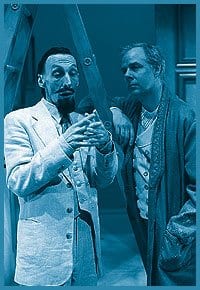Necessary Angel Theatre Company and the National Arts Centre’s production of Last Romantics is an ambitious but seriously flawed rendition of a potentially beautiful and important script.
Michael Lewis MacLennan has made an admirable attempt to write a romantic history about the tragedy of two centuries colliding in war, art, economics, nation building and the construction of collective memory through a reverence for the past. Unfortunately the script and the production rely too heavily upon reverence and too little on crisp, everyday details that might have infused more life into the drama.
Curiously enough there also seems to be a strange hetero-centricity pervading a text about same-sex love. Vague dialogue about women sharing the same bed and two tentative kisses between men who live and die for each other left me wanting a great deal more passion and a great deal less restraint.
A bright light in the midst of all this is the initial appearance of Steven McCarthy as illustrator Aubrey Beardsley. Stylishly performed, this brief section is infused with clever and witty Oscar Wilde-like quips. Although Beardsley’s entrance begins to aid the faltering drama he too falls prey to the same trap from which the rest of the characters never completely free themselves. He becomes maudlin, self-pitying and lacking in the garish, campy, everyday fabulousness needed to save great tragedy from itself.
Ultimately it is the visual focus that is most seriously lacking, exemplified by a huge projection of an impasto impressionist sunset that makes a faded appearance in act two. Like much of the production, lost in a sea of beige, the passion of great painting seems watered down.
MacLennan has written a very complex script that requires another edit and different production values to serve the layered mechanics of his aesthetic vision. Ghosts appearing near the end of the play and interior monologues delivered to the audience by the central character of Charles Shannon, played by Oliver Dennis, are hard to follow partly because there is never any clear signal from the text, or the lighting design, that these are moments set apart from the naturalistic scenes that comprise much of the play. Many of Shannon’s speeches are longish and at times unnecessary companions to scenes that provide enough information without editorializing monologues.
And I really wish Shannon had taken his lavender dressing gown off at least once. He seems lost in a bedroom of misidentified proportions.
This is a potentially important play because it could represent elements of a homophobic history too often forgotten. By rendering the text in vague, pale, somewhat lifeless tones we lose a sense of history, the weight of the past and what may very well have been the spirit of the people who were, in fact, the last romantics.
* Last Romantics continues at Berkeley Street Theatre (26 Berkeley St) until Sat, Mar 22; call (416) 368-3110.

 Why you can trust Xtra
Why you can trust Xtra


